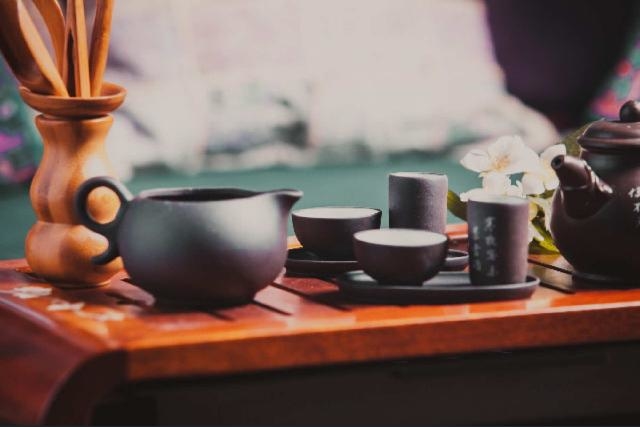We may receive commissions on purchases made from our chosen links at no extra cost to you.
Are you ready to cook Japanese cuisine?! If you are, then that’s great, but what are the must have Japanese kitchen tools you will need? Well, here is a list of 9 types of Japanese cooking kitchenware and cookware that we suggest and which you can easily find in many Asian grocery stores or on the internet.
1. Japanese knives
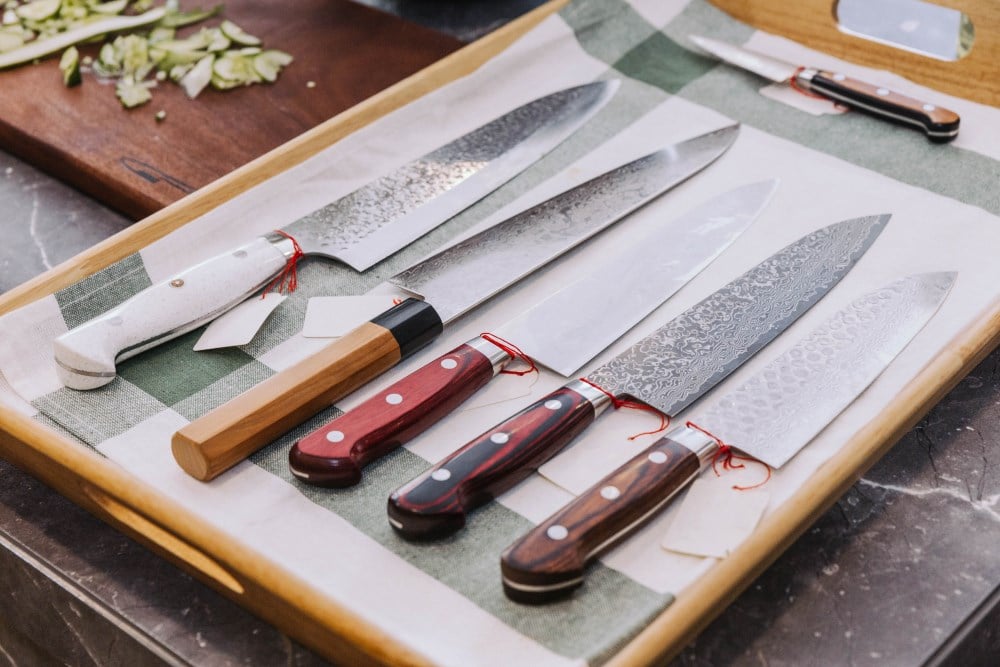
The Japanese knife is essential can be indispensable tool for your kitchen especially if you are a fan of Japanese cuisine! There are several types of Japanese knives, and here are the main four:
- Yanagiba, is a long asymmetrical knife particularly suitable for cutting sashimi
- Santoku is a versatile knife. It can be used to cut meat or vegetables
- Usuba is a more square shaped knife. It is used exclusively for vegetable cutting.
- Deba bocho is a knife that can help you make fish fillets and cut them with more precision.
Which one to choose? To begin with, we recommend the santoku which is quite versatile, then you can use the deba bocho to make sure your fish fillets will look like they are prepared by a pro(you will also look like a pro chef while using these knifes 🙂 ).
Kasumi Deba Japanese Fillet Chef Knife
When you have a Japanese knife on your side a sharpening stone is also an essential and required addition. Your knife must always be sharp to cut food well, right.
You should know that these Japanese knives are made either for a right-handed, left-handed or ambidextrous persons.
💡 You can also check the 8 best Japanese Chef knives from famous Japanese brands in our detailed guide here.
2. Hangiri Rice Mixing Tub.
Rice is omnipresent not only in Asian cuisine which is why a electric rice-cooker is a handy device, because you don’t have much to do to successfully cook rice when using it. But if you want to use more traditional method of cooking rise Japanese style, then you can make your own Japanese rice in a rice mixing tub also called Hangiri.
To finish the preparation of your Japanese rice, you have to spread it in a hangiri, which is a large flat wooden container. Use the rice spatula, made of wood or plastic, to gently mix the rice without crushing it. Often a hand fan is used to cool the rice and make it look shiny. Finally, the hangiri preserves the rice warm and fresh for longer once cooked.
3. A makisu, a bamboo sushi mat
Sushi Making Kit, Bamboo Sushi Mat
The makisu is a kind of small bamboo mat made by weaving fine bamboo stems with a cotton string. Makisu is used mainly for the preparation of maki zushi, but also tamago yaki or to drain the leaves of spinach after cooking.
If you wish to buy these utensils, for your preparations or as a gift, you will find your happiness in the artisans shops of the Kappabashi district in Tokyo.
The makisu mat will allow you to wrap the Maki during preparation. You can also use it to prepare vegetables like spinach or compress tamagoyaki (Japanese omelette) to give it a square shape.
4 Japanese Chopsticks
Japanese chopsticks allow you to look cool while you eat, but also to cook with style! Indeed, there are long Japanese chopsticks called ryoribashi. They are often used for frying and allow to avoid burning and to return the food in the hot oil… there are others a little less long called saibashi which allows serving the hot dishes safely.
Natural Ebony Wood Japanese Natural Wood Chopstick
5. Japanese Square Pan , Takoyaki Pan, Donburi Pan and Japanese Style Steel Wok

1 Square frying pan: this frying pan allows you to make tamagoyaki, the famous Japanese omelettes. It is not necessary tool, but practical.
2 Takoyaki pan: this pan allows you to make small takoyaki balls, you can put the ingredients you want inside, recommended if you are a fan of takoyaki.
3 Donburi frying pan: the handle of this frying pan is vertical and allows to make oyakodon, a rice dish on which a mixture of eggs and chicken is placed.
4 Japanese wok : Japanese recipes are largely inspired by Chinese recipes and many of them use wok which is very useful to mix ingredients thanks to its wide and rounded shape.
These types of pans are not really essential and are more suitable for certain Japanese recipes. You can always use your classic round large pans if you don’t have one of the mentioned above.
6. Sushi Moulds and Presses
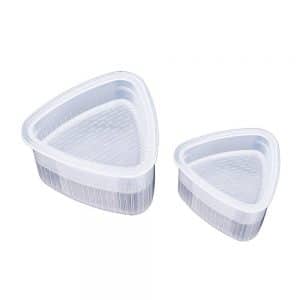
If you are in a hurry and want to make bento for your children, plastic moulds will save you a lot of time!
These are perfect for making onigiri (rice balls) for example, maki, gyoza (Japanese ravioli), suchi and sweets with original shapes.. made of plastic or cast iron, we admit it is very practical and efficient accessory!
Tip: you can moisten them so that the rice does not stick when in contact with the mold, so you can unmoulder it more easily.
>
 Inomata 0787 Triangle Sushi Mold, White
Inomata 0787 Triangle Sushi Mold, White
7. Japanese Mandolin Slicer
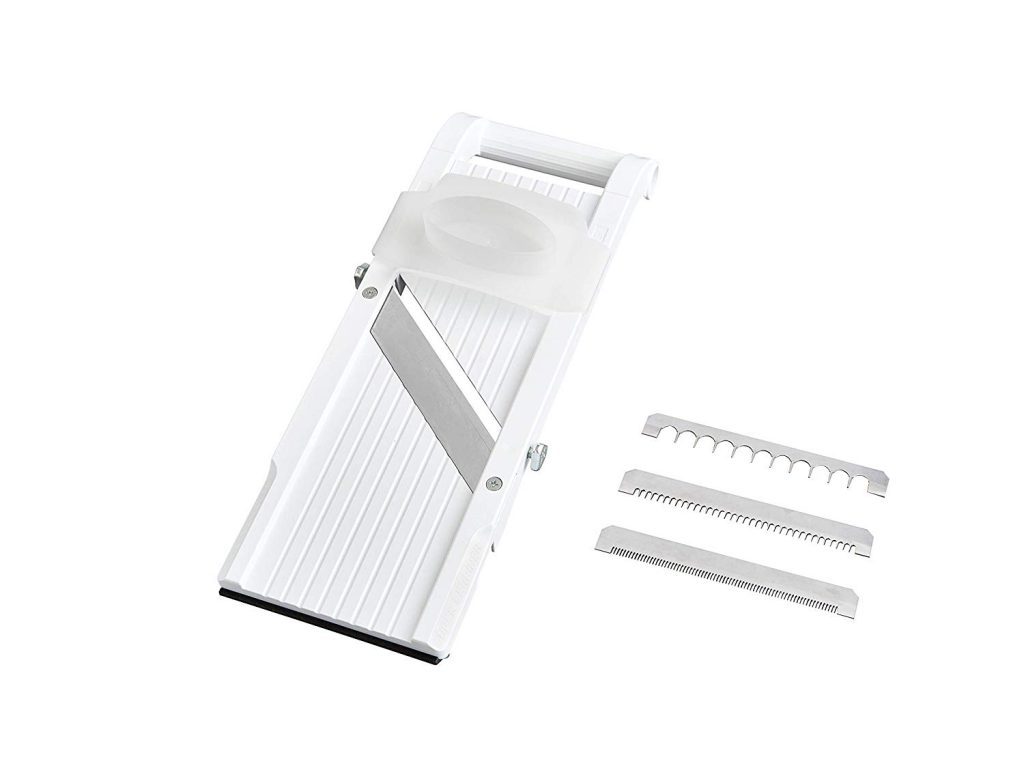
The mandolin slicer is quite new and trendy Japanese kitchen tool, but above all very easy to use. It’s extremely practical, ecological, small in size and very economical.
It’s perfect for small spaces and especially for small kitchens. Moreover, it is also the ideal utensil for those who are tired of equipping themselves and storing large machines in their kitchen cabinets. It is also suitable for anyone who wants to cook simple and quick recipes like fresh salads for example.
The Japanese mandolin is the perfect kitchen tool to surprise all of your guests or simply to prepare a nice plate of vegetables and especially fresh fruit salads.
A kitchen mandolin, whether you use it for cutting, grating or slicing thin slices of vegetables or fruits is often the most practical utensil to use due to the quality of the cut it makes and the efficiency of this Japanese kitchen tool.
Taking only a small storage space, it would easily find its place in your kitchen, it does not require electricity and is easier to clean than electric models.
There are many types of mandolin slicers on the market. They range from a few dollars you can buy at the corner shop to few hundred dollars for high-end models which are offering better safety and precision for the user.
You can find more information about Japanese mandolin slicers in our comprehensive comparative guide article on the best models.
8. Cast Iron Teapot
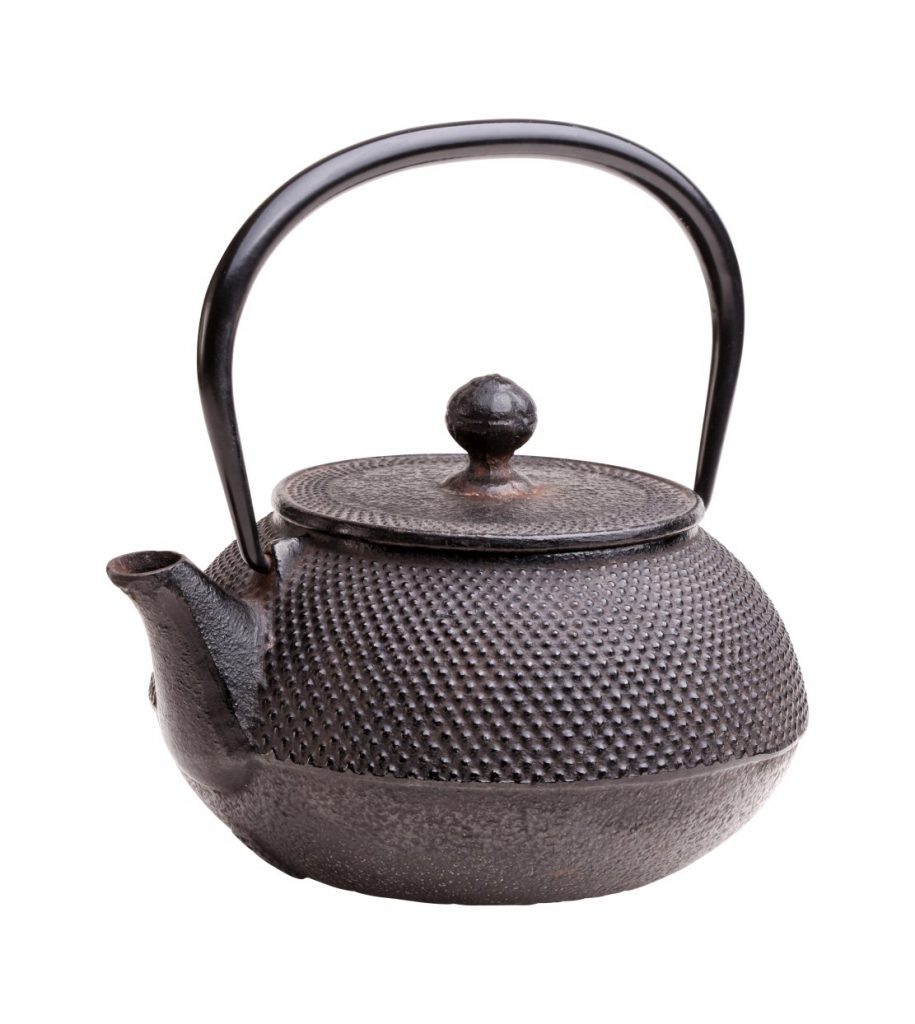
classic Japanese iron teapot-kettle
In Japanese cuisine some salty recipes also use green tea either infused or as decorative addition to dishes like chazuke.
Green tea is a must for almost all Japanese dishes, so a teapot is an essential accessory in Japanese kitchen tools and especially if you are a tea lover. Be it Sencha, Dragonwell or other type of green tea you won’t regret buying a cast iron teapot for your tea preparation. When you buy tea always search for high quality and freshness as this is very important when brewing tea.
Genuine properly stored loose leaf tea made in such teapot will certainly give you a wonderful tea drinking experience.
If you are shopping for Japanese cast iron teapot, make sure you choose a quality teapot like the 3 we picked for you below:
Primula Green Drangonfly Cast Iron Teapot
Iwachu 29-Ounce Japanese Iron Hobnail Tetsubin Teapot, Large, Black
Iwachu Iron Teapot Tetsubin, Green Pine Needle
💡 You can also check the 6 top cast iron teapots based on our research in this detailed guide.
9. A Few other Basic Japanese kitchen Tools and Accessories
When you are diving deeper into the world of Japanese food and its preparation you will definitely need a few additional utensils. These include a skillet pan, a frying pan with a lid, a colander, a salad bowl, kitchen scissors, a dosing machine and a mortar and pestle…
The other accessories you should have and which will be very useful in your Japanese kitchen, are a kitchen machine and a blender… then you will be very well equipped to start your cooking journey!
Having a damp cloth next to you will also be important as it is used to keep your hands moist when handling rice, it is also used to moisten your knife and clean it when cutting. Having wet hands is essential and will allow you to make the rice less sticky.
And for food lovers, a wasabi grater is a plus (you can use any normal grater for that purpose)! Fresh wasabi is delicious and has nothing to do with the green fluorescent paste we know from Japanese restaurants.
Where to get these utensils in Japan?
If you are going to Japan and would like to get these utensils from there we have some suggestions. Any neighborhood in Tokyo will allow you to buy these accessories. And more precisely you can go to the street of Kappabashi located between Ueno and Asakusa. You will recognize it easily thanks to the huge chef’s Head sign at the top of the building!
In more than 200 specialized shops around Japan you will find everything, Japanese knives, chopsticks, bento boxes, moulds, presses. And these famous sampuru (plastic artificial food) … you will be delighted! This is definitely a place to visit!
Of course if you don’t plan a trip to Japan anytime soon, you can just buy all of these from places like Amazon. Just check the links below:
- Japanese chopsticks
- Japanese cast iron Teapots
- Frying pan with a lid
- Japanese salad bowl
- Japanese kitchen scissors
- Japanese pestle & mortar
- Kotobuki Japanese Fish Bone Tweezers
In order to understand the various kitchen utensils used in Japanese culture you have to know more about the history of its cuisine. So, let’s take a little deeper look into that matter.
History and Origin of Japanese Cuisine and Kitchen Tools
Research shows that It all began in the prehistoric era (Jomon period) somewhere around 14,000–300 BCE. At that time the early Japanese Neolithic people based their diet mainly on rice and seafood or what ever was available.
According to some sources, a framework of well-defined eating habits was established only at the time of the formation of the Yamato dynasty. When Buddhism became common practice, Japan was introduced to the meat ban, which will remain in effect until the Meiji Restoration. During the Heian period, Japanese nutrition documents became more available, allowing people to easily make a list of ingredients and methods of food preparation. This was not really possible in earlier times when it was mainly traditions that passed that knowledge among the population..
Once Japan entered the Edo period, It was introduced to a rich variety of dishes and culinary specialties, which will make Japanese cuisine traditional as we know it today. In the Meiji period, with the abolition of sakoku, several foreign specialties will complete the already rich selection of Japanese dishes.
The dishes and culinary traditions introduced in this area and in subsequent periods, will gradually compose one that is still labeled as traditional Japanese cuisine (日本 料理 nihon ryori, or washoku 和 食), which means that all the previous cuisine from the Meiji era will see the introduction of a foreign cuisine traditions. The changes introduced in the Nara period concern the methods of brewing and the introduction of ingredients such as bread and natto. Also the provision of salt and vinegar, replaced by other condiments such as miso, hishio (The ancestor of soy sauce) and shi.
Fermentation is an essential process for the preparation of many ingredients and dishes in the Japanese cuisine (to name only the most famous: miso, sake, soy sauce, rice vinegar, mirin, tsukemono, natto, katsuobushi, kusaya).
Since fermentation is a fungus dependent process, it took a long time before the Japanese were able to fully control and master it. Evidence for the usage of this method can be found in the Kin-Jinja Temple in Shiga Prefecture, which is dedicated to the mushroom used for the production of Narezushi, an ancestor of sushi, in which the fish is salted and then wrapped in fermented rice.
This prevented the rotting of the fish added in Narezushi, so that it could be stored for months. In this specific dish, fermented rice has been discarded, and mainly fish was used in the preparation. This type of sushi was an important source of protein for the Japanese at the time.
The introduction of foreign cuisine in Japanese cuisine began in the early Meiji period (1868-1912). The sakoku is abrogated by ‘Emperor Meiji, which aims to promote Western ideas and recipes, which was considered the future of Japanese cuisine back then. Among the reforms initiated by the emperor was that he revoked the ban on the consumption of red meat, opening the doors to Western cuisine, which was considered the reason for the prosperity of the Western culture on the Japanese archipelago.
The transformation of the Japanese diet is twofold: on the one hand, recipes are introduced with foreign technologies, expanding the range of flavors of Japanese cuisine. On the other hand, the elimination of the ban on eating meat added to the increase in milk and bread consumption, which causes a decrease in the consumption of rice, the caloric intake of which is supplanted by animal proteins. New ingredients from western countries are adapted to local tastes too.
These recipes are adapted for the most part according to the Japanese culture from which they originated, and vice versa. In Japan, they are not considered part of traditional Japanese cuisine, although it is recognized as part of the Japanese culinary heritage.
Under the influence of Western cuisine, meat, milk and bread are introduced into Japanese cuisine, effectively changing the habits of the Japanese; the milk supply is a classic ingredient in the diet of Japanese youth now. This contributes to a considerably richer nutrition of the common Japanese diet currently. In contrast before World War 2, in 1939, food and specifically rice was rationed at 330 grams of rice per person per day. So, all this diet westernization change makes for quite a difference nowadays.
In Japanese, the term Yoshoku (洋 食? “Western cuisine”) indicates dishes whose recipe was imported from the West during the Meiji Restoration and adapted to local tastes. There are many European dishes that have been adapted, which often have European names, which are then usually transcribed using katakana. These dishes are generally consisting of meat, a relatively new ingredient in Japanese cuisine, whose origins is mostly European (French, English or Italian). These Japanese versions are often very different from their original versions though.
The average consumption of rice in 2000 decreased to 165 grams, while the usage of rice was replaced by the consumption of meat protein. Between 1960 and 2000, meat consumption increased by a whopping 400% and by the mid-eighties, the ratio between meat and fish consumed by the average Japanese person was reversed, with meat consumption largely exceeding that of fish.
Given all the richness and abundance of tastes it’s understandable if you really want to immense your senses with the wonderful dishes offered by the welcoming Japanese culture.
So, if you want to fully experience ancient times st your home your best bet to accomplish that would be to use some of these vintage Japanese kitchen utensils:
Yeking Japanese Vintage Noodle Bowl
Amoysanli Kitchen Canisters Vintage Ceramic Food Storage Jar
Whatever you choose from these options you will get to taste the unique ancient spirit of the wonderful and rich Japanese culture. Even if you pick one of the modern kitchen tools made according to the traditional style of Japanese craftsmanship, you certainly won’t regret it.
If you are a fan of Japanese culture and love Japanese cuisine as much as we do, you will definitely get to enjoy your time in the kitchen when you buy any of the Japanese kitchen tools we mentioned above.
If you have any questions or want to share your experience with us feel free to let us know in the comments below.









